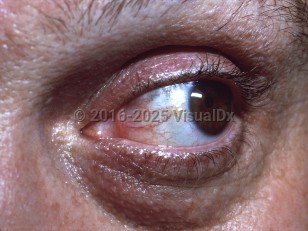Ochronosis
See also in: External and Internal EyeAlerts and Notices
Important News & Links
Synopsis

Ochronosis (also known as endogenous ochronosis or alkaptonuria) is an inherited disorder caused by the defective metabolism of homogentisic acid (HGA), a product of tyrosine metabolism. The disease typically presents at birth with urine that darkens with prolonged exposure to air due to increased urinary HGA excretion and later with a blue-black discoloration of connective tissues due to the deposition of polymerized HGA.
Endogenous ochronosis is inherited in an autosomal recessive manner. It is relatively uncommon with an estimated incidence of 1 in 250 000-1 000 000 live births in the United States. Male and female patients are affected with equal frequency, although symptoms tend to manifest earlier in males. It has been diagnosed worldwide, but certain regions such as Slovenia, Germany, and the Dominican Republic have been noted to have a higher incidence. Affected individuals have a normal life expectancy.
Endogenous ochronosis is caused by mutations in the homogentisate 1,2 dioxygenase (HGD) gene. Lack of HGD function results in elevated serum HGA levels and increased excretion in the urine and sweat. HGA darkens with oxidation on exposure to air, but this process requires several hours and can often be missed. Prolonged elevation in HGA levels results in deposition in connective tissues, particularly the cartilage, and can lead to a blue-black discoloration that becomes more noticeable in early adulthood. Moreover, the deposition of HGA can lead to tissue damage and the gradual development of arthritis (ochronotic osteoarthropathy) that typically becomes pronounced in the weight-bearing joints by the fourth decade of life. HGA deposition in cardiac connective tissues can cause early-onset valvular calcifications and severe stenosis. Affected patients also have a higher likelihood of developing kidney stones.
Related topic: Exogenous ochronosis
Endogenous ochronosis is inherited in an autosomal recessive manner. It is relatively uncommon with an estimated incidence of 1 in 250 000-1 000 000 live births in the United States. Male and female patients are affected with equal frequency, although symptoms tend to manifest earlier in males. It has been diagnosed worldwide, but certain regions such as Slovenia, Germany, and the Dominican Republic have been noted to have a higher incidence. Affected individuals have a normal life expectancy.
Endogenous ochronosis is caused by mutations in the homogentisate 1,2 dioxygenase (HGD) gene. Lack of HGD function results in elevated serum HGA levels and increased excretion in the urine and sweat. HGA darkens with oxidation on exposure to air, but this process requires several hours and can often be missed. Prolonged elevation in HGA levels results in deposition in connective tissues, particularly the cartilage, and can lead to a blue-black discoloration that becomes more noticeable in early adulthood. Moreover, the deposition of HGA can lead to tissue damage and the gradual development of arthritis (ochronotic osteoarthropathy) that typically becomes pronounced in the weight-bearing joints by the fourth decade of life. HGA deposition in cardiac connective tissues can cause early-onset valvular calcifications and severe stenosis. Affected patients also have a higher likelihood of developing kidney stones.
Related topic: Exogenous ochronosis
Codes
ICD10CM:
E70.29 – Other disorders of tyrosine metabolism
SNOMEDCT:
410042009 – Ochronosis due to homogentisate 1,2-dioxygenase deficiency
E70.29 – Other disorders of tyrosine metabolism
SNOMEDCT:
410042009 – Ochronosis due to homogentisate 1,2-dioxygenase deficiency
Look For
Subscription Required
Diagnostic Pearls
Subscription Required
Differential Diagnosis & Pitfalls

To perform a comparison, select diagnoses from the classic differential
Subscription Required
Best Tests
Subscription Required
Management Pearls
Subscription Required
Therapy
Subscription Required
References
Subscription Required
Last Reviewed:10/28/2019
Last Updated:01/20/2022
Last Updated:01/20/2022
Ochronosis
See also in: External and Internal Eye
